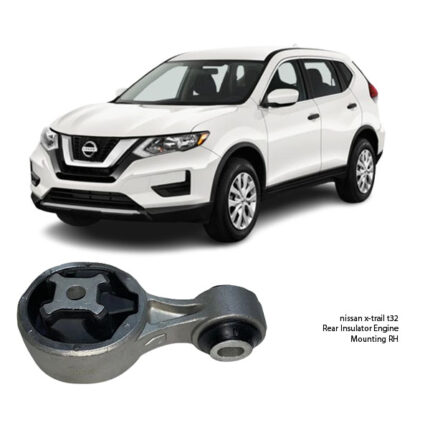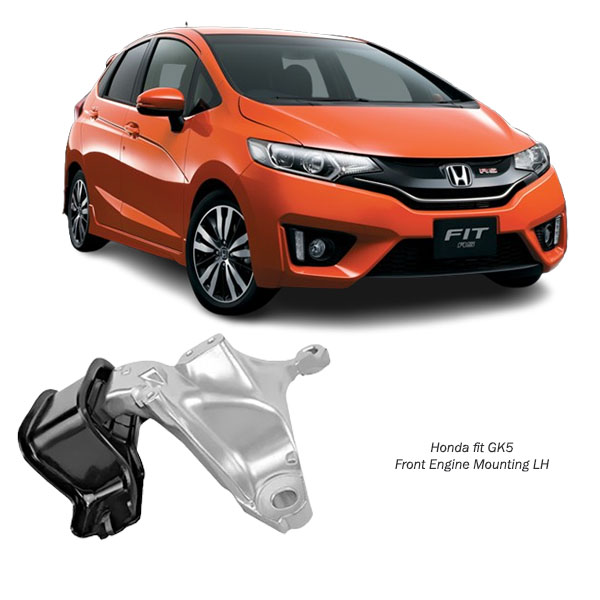-8%
Get Honda fit GK5 Front Engine Mounting LH 50850-t5a-912 in Kenya
The front engine mounting (LH), or left-hand engine mount, is a key part of a vehicle’s engine support system. Its role is crucial for maintaining the stability and alignment of the engine, reducing vibrations, and ensuring that the engine remains securely fastened to the vehicle’s frame. This component significantly contributes to the overall smoothness, comfort, and performance of a vehicle.
In this 1000-word detailed guide, we will explore the front engine mounting (LH), covering its function, structure, types, signs of failure, and maintenance tips.
1. What is the Front Engine Mounting (LH)?
The front engine mounting (LH) refers to the engine mount located at the front and on the left-hand side of the vehicle’s engine bay (from the driver’s perspective). This mount helps support the engine and transmission assembly, absorbing and damping vibrations caused by the engine during operation. The engine mounts are typically positioned in such a way that they stabilize the engine, keeping it aligned with the chassis and minimizing its movement.
Since the engine is a heavy component that produces torque and vibrations, these mounts are designed to keep the engine firmly in place while allowing a certain amount of flexibility to absorb the shocks and vibrations produced during driving.
2. Construction of the Front Engine Mounting (LH)
The typical front engine mounting (LH) consists of the following components:
- Metal Bracket: A sturdy metal bracket (usually made of steel or aluminum) that attaches the engine to the vehicle’s frame. This provides the structural support for the engine.
- Rubber or Elastomer Insulator: Sandwiched between the metal components is a rubber or elastomer section that acts as a damping material to absorb vibrations. This insulator reduces the transfer of vibrations from the engine to the chassis and ultimately the cabin.
- Hydraulic Fluid Chamber (Optional): In some cases, particularly in modern hydraulic engine mounts, there is a chamber filled with hydraulic fluid to provide additional damping.
- Mounting Bolts: High-strength bolts secure the mount to both the engine and the chassis.
The combination of metal and rubber/elastomeric materials allows the mount to be both rigid (for engine support) and flexible (to absorb vibrations). The rubber or elastomer section is particularly important for isolating engine noise and vibrations from the vehicle’s occupants.
3. Functionality and Role in the Vehicle
The front engine mounting (LH) serves multiple critical functions:
- Engine Stability: The mount holds the engine firmly in place, preventing it from shifting or moving during driving. This is particularly important when the vehicle accelerates, decelerates, or makes turns, as the engine generates significant forces that could cause unwanted movement.
- Vibration and Noise Dampening: Engine mounts, particularly those equipped with rubber or hydraulic fluid, are designed to absorb and dampen the vibrations produced by the engine. Without these mounts, engine vibrations would be directly transferred to the chassis, making the ride uncomfortable and noisy.
- Torque Control: During acceleration or hard braking, the engine produces torque, which can cause it to twist or rotate slightly. The engine mounts, including the front left mount, are designed to control this movement, ensuring that the engine stays in the correct position relative to the drivetrain.
- Transmission of Power: By securing the engine in the correct alignment, the engine mounts ensure that power is efficiently transmitted to the drivetrain. If the engine moves out of alignment, it can cause strain on the transmission and other components, leading to reduced performance or even mechanical failure.
4. Types of Engine Mounts (Including Front LH Engine Mounts)
There are different types of engine mounts, each offering specific benefits depending on the vehicle and its driving conditions. The front engine mounting (LH) can be of any of the following types:
- Rubber Engine Mounts: These are the most common type of engine mount. They use rubber as the primary damping material to absorb vibrations. Rubber mounts are simple, reliable, and inexpensive but can wear out over time due to heat and stress.
- Hydraulic Engine Mounts: In hydraulic mounts, a fluid-filled chamber is used in conjunction with rubber or elastomer to provide additional damping. These mounts are more effective at reducing vibrations, particularly under varying engine loads, making them ideal for modern vehicles that prioritize ride comfort.
- Active Engine Mounts: Some high-end vehicles are equipped with electronically controlled engine mounts that adjust their damping properties in real-time based on the driving conditions and engine load. These mounts provide the best vibration control but are more expensive and complex.
For most passenger vehicles, the front engine mounting (LH) is either a rubber or hydraulic mount, as these offer the right balance between cost, durability, and performance.
5. Common Signs of a Failing Front Engine Mount (LH)
Like any mechanical component, the front engine mount can wear out over time. Here are some common signs that indicate the front left engine mount may be failing:
- Excessive Vibrations: One of the first symptoms of a worn engine mount is an increase in the amount of vibration felt inside the cabin, especially when idling. The rubber or hydraulic material may have degraded, reducing the mount’s ability to absorb vibrations.
- Clunking or Banging Noises: A damaged or loose engine mount may cause the engine to shift or move excessively. This can lead to clunking, knocking, or banging noises, particularly when accelerating, braking, or going over bumps.
- Engine Movement: If the mount is severely worn or broken, the engine may move out of its normal position. This can often be seen as excessive engine rocking or movement, especially when the vehicle is in gear or revving.
- Misaligned Engine/Transmission: A failing engine mount may cause the engine or transmission to become misaligned, leading to drivetrain issues such as vibrations during acceleration, gear shifting problems, or uneven wear on drivetrain components.
- Rough Idling: If the engine mount has lost its ability to properly support the engine, you may notice rough or erratic idling. The engine may move excessively at low RPMs, causing vibrations and noise.
6. Causes of Engine Mount Failure
Several factors can contribute to the failure of the front engine mounting (LH):
- Wear and Tear: Over time, the rubber or hydraulic material in the mount can wear out due to constant exposure to heat, engine vibrations, and stress.
- Engine Misalignment: If the engine is not properly aligned or if other mounts have failed, the additional stress can cause the front engine mount to fail prematurely.
- Exposure to Oil or Fluids: Oil leaks from the engine or transmission can degrade the rubber or elastomer in the mount, causing it to lose its effectiveness.
- Excessive Engine Torque: High-performance or heavily loaded engines may produce more torque than the engine mounts are designed to handle, causing them to wear out more quickly.
7. Importance of Maintenance and Replacement
Regular inspection and maintenance of the engine mounts, including the front left mount, is essential for vehicle performance and comfort. Here are a few maintenance tips:
- Inspect Regularly: During routine maintenance or when performing work on the engine, inspect the mounts for signs of wear, cracking, or movement. Any visible damage should be addressed immediately.
- Replace as Necessary: Engine mounts do not need to be replaced frequently, but if they show signs of significant wear or if they are causing noticeable symptoms (vibration, noise, movement), it is important to replace them. Delaying replacement can lead to further damage to the engine, transmission, and drivetrain.
- Use Quality Parts: When replacing the engine mount, use high-quality OEM (original equipment manufacturer) or aftermarket parts that are specifically designed for your vehicle model. This ensures proper fitment and performance.
8. Conclusion
The front engine mounting (LH) is a critical component in the overall stability and performance of a vehicle. By supporting the engine, absorbing vibrations, and preventing excessive movement, this mount plays a significant role in ensuring a smooth and comfortable ride. Regular inspection, timely maintenance, and prompt replacement of worn or damaged engine mounts can prevent costly damage to the engine and transmission, maintaining the overall health of the vehicle. Understanding the importance of this component and the signs of failure can help keep your vehicle running smoothly for years to come.
Follow us on Facebook for more parts.




